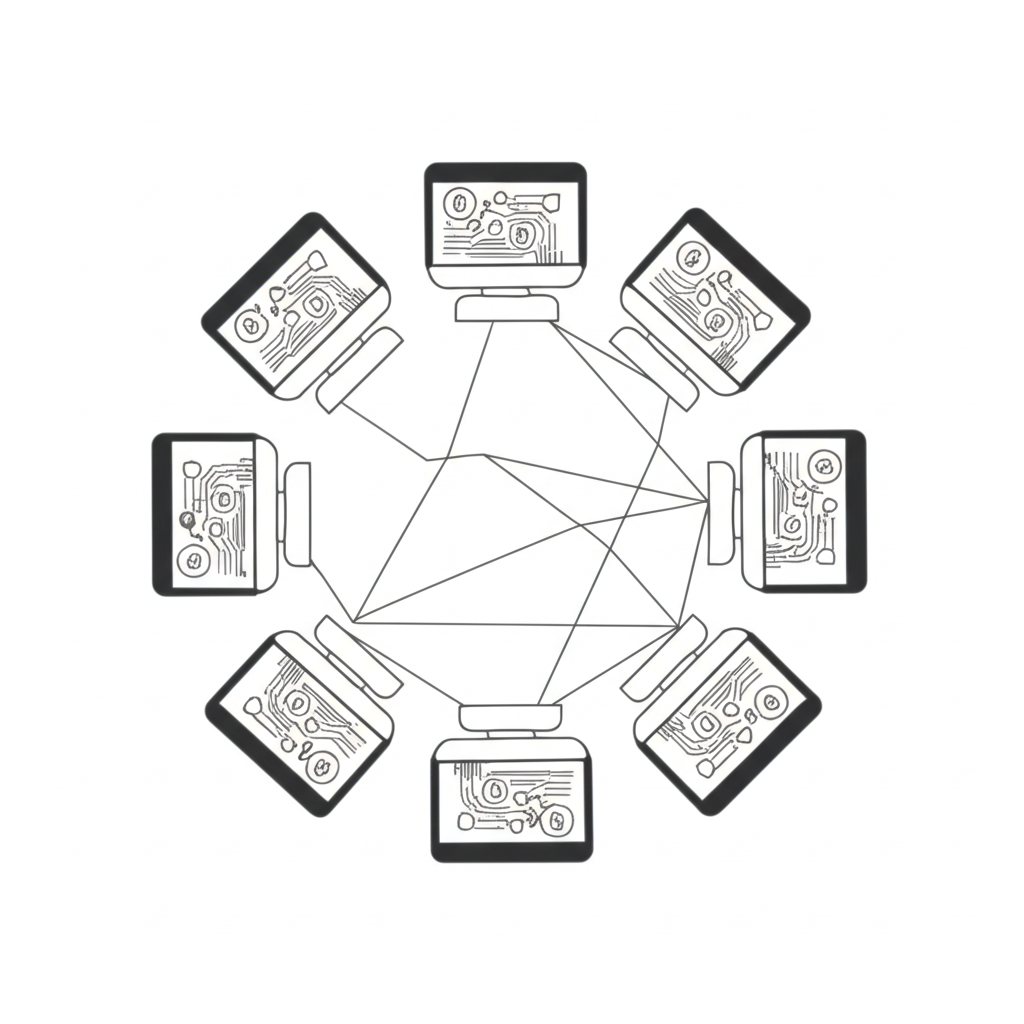Introduction: What Exactly Are Full Nodes in Blockchain?

At the heart of every decentralized blockchain network lies a powerful, often unsung participant: the full node. Unlike centralized databases managed by a single authority, blockchains rely on a distributed network of computers to maintain their integrity. A full node is one such computer—running specialized software that downloads, stores, and validates the entire blockchain history, from the very first block to the most recent addition. This complete copy of the ledger allows it to act as an independent auditor, enforcing the protocol’s consensus rules without relying on any third party.
Full nodes are more than passive record-keepers; they are active enforcers of truth. By verifying every transaction and block against a strict set of network-defined criteria, they ensure no invalid data can slip through. Whether it’s checking for double-spending, validating digital signatures, or confirming block structure, a full node does not assume correctness—it proves it. This capability is what enables trustless interactions in cryptocurrencies: users don’t need to trust other participants, only the protocol, which full nodes collectively uphold.
The Core Function: How Full Nodes Operate and Validate the Blockchain

When a full node first connects to a blockchain network, it begins a process known as synchronization. This involves downloading and verifying every block in the chain, one by one, starting from the genesis block. For networks like Bitcoin or Ethereum, this can mean ingesting hundreds of gigabytes—or even multiple terabytes—of data. But the real work begins once the initial sync is complete.
As new blocks are broadcast across the network, full nodes receive them and conduct a rigorous series of checks. Each transaction within a block must be valid: the inputs must reference unspent outputs, the cryptographic signatures must be correct, and there must be no attempt to spend the same coins twice. Beyond transactions, the block itself must meet consensus requirements. In Proof-of-Work systems like Bitcoin, this includes verifying the block’s hash meets the current difficulty target. In any system, timestamps must be reasonable, the Merkle root must match the included transactions, and the block size must not exceed protocol limits.
If even one element fails inspection, the block is rejected outright. No exceptions. This strict enforcement ensures that only compliant data becomes part of the permanent record. Because each full node independently performs these checks, no single entity can manipulate the chain. Instead, the network’s state emerges from a decentralized consensus—each node agreeing on what is valid, simply by following the rules.
Why Full Nodes Are Indispensable for Blockchain Security and Decentralization

The strength of a blockchain doesn’t come from its code alone, but from how widely and independently it is validated. Full nodes are the foundation of this resilience. They serve as decentralized checkpoints, each one silently but constantly verifying the integrity of the entire system. When a malicious actor attempts to submit an invalid transaction—say, trying to spend coins they don’t own—full nodes immediately flag the discrepancy and reject it. This creates a self-healing network where fraud has no place to hide.
Decentralization, a core promise of blockchain technology, depends heavily on the distribution of full nodes. The more geographically and operationally diverse the node network, the harder it becomes for any single entity—be it a corporation or a government—to exert control. Each full node operates autonomously, choosing which chain to follow based on consensus rules, not external pressure. For example, the Bitcoin network’s robustness is reflected in the estimated tens of thousands of reachable full nodes spread across the globe, as tracked by tools like Bitnodes. This wide distribution eliminates single points of failure and makes censorship extremely difficult.
Beyond security and decentralization, full nodes empower individual users. By running one, a person can verify transactions directly, without relying on third-party services like exchanges or block explorers. This self-validation grants true financial sovereignty—the ability to confirm one’s own balance, check transaction status, and send payments—all without exposing personal data or trusting an intermediary. In this sense, full nodes are not just technical components; they are tools of personal empowerment in a digital economy.
Dissecting Node Types: Full Nodes vs. Other Blockchain Participants

While all nodes contribute to network functionality, their roles, capabilities, and trust models vary significantly. Understanding these distinctions is key to grasping how blockchains operate in practice.
Full Nodes vs. Light Nodes (SPV Clients)
Light nodes, or Simplified Payment Verification (SPV) clients, are designed for efficiency. Instead of storing the full blockchain, they download only block headers—compact summaries that include metadata like timestamps and Merkle roots. To verify a transaction, a light node requests a cryptographic proof from a full node that the transaction is included in a valid block. This approach drastically reduces storage and bandwidth needs, making it ideal for mobile wallets and users with limited resources.
However, this convenience comes at a cost. Light nodes must trust that the full nodes they connect to are honest. If all connected full nodes are compromised or colluding, a light node could be misled. In contrast, a full node needs no such trust—it verifies everything independently.
Full Nodes vs. Mining Nodes
Mining nodes are responsible for creating new blocks in Proof-of-Work blockchains. They gather pending transactions, bundle them into a candidate block, and compete to solve a computationally intensive puzzle. The first to find a valid solution broadcasts the block to the network.
While mining nodes often run full nodes to ensure they’re building on the correct chain, their primary goal is profit-driven block creation. A full node, on the other hand, has no such incentive—it exists solely to validate and propagate data. Importantly, not every miner runs their own full node, though doing so is considered best practice. Mining on an invalid chain can lead to wasted resources and rejected blocks, a risk mitigated by independent validation.
Full Nodes vs. Pruned Nodes
A pruned node is a variation of a full node optimized for storage efficiency. Like a standard full node, it downloads, verifies, and processes the entire blockchain during initial sync. However, once a block has been fully confirmed and integrated, older data is discarded. The node retains enough recent blockchain history to validate new transactions—typically the last few gigabytes—but does not store the complete ledger indefinitely.
Despite this pruning, the node remains a full validator: it checks all new blocks and transactions against consensus rules. The main trade-off is that it cannot serve historical data to other nodes, limiting its utility as a data provider. For individuals prioritizing validation over archival, this is a practical compromise.
Full Nodes vs. Master Nodes
Master nodes operate in a different category, typically found in Proof-of-Stake or hybrid blockchain systems. They require operators to lock up a significant amount of cryptocurrency as collateral—often referred to as a “staking requirement.” In return, they provide advanced services such as enabling instant transactions, anonymized payments, or participating in governance decisions.
These nodes are directly incentivized, often receiving regular rewards in the form of transaction fees or newly minted coins. This contrasts sharply with standard full nodes, which do not receive monetary compensation. The presence of master nodes introduces a layered node economy, where different participants contribute in different ways based on their resources and commitments.
| Feature | Full Node | Light Node (SPV) | Pruned Node | Master Node |
|---|---|---|---|---|
| Blockchain Data | Stores entire ledger history | Stores only block headers | Stores recent history; discards old | Stores entire ledger (typically) |
| Validation | Independent, verifies all transactions | Relies on full nodes for verification | Independent, verifies all transactions | Verifies transactions; performs specific services |
| Trust Model | Trustless | Relies on full nodes for trust | Trustless | Trustless (for its own chain) |
| Resource Req. | High (storage, bandwidth, CPU) | Low | Moderate (less storage than full) | High (collateral, storage, bandwidth) |
| Incentives | Generally none (intrinsic) | None | Generally none | Staking rewards, service fees |
| Primary Role | Security, decentralization, validation | Quick access, low resource use | Security, validation (resource-efficient) | Governance, special services, network stability |
The Benefits and Challenges of Running Your Own Full Node
Operating a full node is more than a technical hobby—it’s a meaningful contribution to the health and resilience of a blockchain network. But like any infrastructure project, it comes with both rewards and demands.
Advantages of Operating a Full Node
Running your own full node fundamentally changes how you interact with a blockchain. Instead of relying on third-party services, you become a direct participant in the network’s consensus mechanism. This shift brings tangible benefits:
- Maximum Security: You eliminate the risk of trusting compromised or misconfigured services. Your node independently verifies every transaction, ensuring your funds are safe from fraudulent activity.
- Improved Privacy: Without routing your activity through external servers, your IP address and transaction patterns remain hidden from prying eyes. This is especially valuable in jurisdictions with strict surveillance policies.
- Direct Network Access: Transactions are broadcast and confirmed through your own infrastructure, reducing latency and dependency on potentially unreliable services.
- Contribution to Decentralization: Every additional full node makes the network more robust. More nodes mean greater resistance to censorship, Sybil attacks, and centralized control.
- Full Autonomy: You gain complete control over your data and interactions, aligning with the core ethos of cryptocurrencies: self-sovereignty and permissionless access.
Requirements and Potential Challenges
Despite these advantages, running a full node is not without hurdles. Prospective operators should consider the following:
- Storage Space: Bitcoin’s blockchain currently exceeds 500GB and grows steadily. Ethereum’s full node, especially in archival mode, can surpass several terabytes. Fast SSD storage is strongly recommended to prevent performance bottlenecks.
- Bandwidth: Full nodes constantly exchange data with peers. A stable, unmetered internet connection is essential. Bitcoin nodes can consume hundreds of gigabytes of upload and download traffic monthly, as noted in the official Bitcoin Core documentation.
- Initial Sync Time: The first synchronization can take days or even weeks, depending on hardware and network speed. Patience is required during this phase.
- Power and Maintenance: While not energy-intensive like mining, a full node runs continuously. This incurs modest electricity costs and requires occasional updates or troubleshooting.
- Technical Knowledge: Though user-friendly tools exist, understanding basic networking, storage management, and security practices is helpful for setting up and maintaining a reliable node.
Conclusion: The Enduring Importance of Full Nodes in the Evolving Blockchain Landscape
Full nodes are the silent guardians of blockchain networks. They do not seek profit, nor do they command attention. Yet their presence is vital. By independently validating the entire ledger, they enforce the rules that keep blockchains secure, transparent, and resistant to manipulation. They are the backbone of decentralization, ensuring that no single entity can rewrite history or impose arbitrary control.
As blockchain technology evolves—with layer-2 scaling, sharding, and new consensus models—the role of the full node remains unchanged. It continues to be the ultimate source of truth, the final arbiter of validity. While light clients and specialized nodes serve important functions, they ultimately depend on full nodes for accurate data. In this way, the full node is not just a component of the network—it is the foundation upon which trustless, peer-to-peer digital systems are built. As long as blockchains aim to remain open and permissionless, full nodes will remain essential.
1. Do full nodes get paid, and if not, why do people run them?
No, standard full nodes do not receive direct financial rewards for their operation. The motivation is largely intrinsic and ideological:
- Security and Privacy: Running a full node allows users to verify transactions themselves, removing the need to trust third parties and enhancing personal privacy.
- Supporting Decentralization: Each additional node strengthens the network’s resilience against attacks and censorship.
- Direct Access: Operators gain immediate, uncensored interaction with the blockchain, improving reliability and control.
It’s important to note that other node types, such as master nodes or staking nodes in certain Proof-of-Stake systems, do receive economic incentives in exchange for collateral and additional responsibilities.
2. What is the primary difference between a full node and a light node in blockchain architecture?
The main distinction lies in data storage and validation independence:
- Full Node: Stores the complete blockchain from genesis and independently verifies every transaction and block, requiring no trust in others.
- Light Node: Stores only block headers and depends on full nodes to prove transaction inclusion, trading security for lower resource usage.
3. How does a full node contribute to the overall security and decentralization of a blockchain network?
Full nodes are critical to network integrity:
- Validation: They independently check all transactions and blocks, rejecting any that violate consensus rules.
- Rule Enforcement: By refusing invalid data, they ensure all participants follow the same protocol, preserving ledger accuracy.
- Decentralization: A distributed network of full nodes prevents central control, making the system more resistant to censorship and coordinated attacks.
4. Can I run a full node on my personal computer, and what are the minimum hardware requirements?
Yes, a full node can run on a personal computer, though dedicated hardware is often preferred for reliability. Minimum requirements vary by blockchain:
- Storage: 500GB+ SSD for Bitcoin; 1TB+ for Ethereum (and growing).
- RAM: At least 8GB.
- CPU: A modern dual-core processor or better.
- Internet: A stable, high-speed connection with sufficient upload bandwidth.
- OS: Compatible with Linux, Windows, or macOS.
5. What is a pruned node, and how does it differ from a standard full node?
A pruned node is a space-optimized version of a full node:
- Initial Sync: Downloads and validates the entire blockchain like a standard full node.
- Data Retention: After validation, it deletes older block data, keeping only recent blocks to save storage.
Both types independently validate new blocks, but pruned nodes cannot serve historical data to other nodes.
6. Are there different types of full nodes, or are they all essentially the same?
While the core function—full validation—remains consistent, variations exist:
- Standard Full Node: Stores the complete blockchain history.
- Pruned Node: Stores only recent blocks after validation.
- Archival Node: Used primarily in Ethereum, retains full historical state data, requiring massive storage.
- Feature-Enhanced Nodes: May include additional capabilities like Lightning Network support or smart contract indexing.
Despite differences in configuration, all adhere to the fundamental principle of independent validation.
7. What is the purpose of a blockchain node in general, and how do full nodes fit into this?
A blockchain node is any computer participating in the network. Its general roles include storing data, relaying transactions, and maintaining network connectivity. Full nodes are the most critical category because they validate all data against consensus rules. They form the trust anchor that other nodes—like light clients or mining nodes—depend on, making them the cornerstone of network security and decentralization.
8. How many full nodes are currently active in major blockchain networks like Bitcoin or Ethereum?
Exact numbers fluctuate, but reliable estimates exist:
- Bitcoin: Publicly reachable nodes often number in the tens of thousands, as shown by Bitnodes, with many more likely running privately.
- Ethereum: Estimates range from several thousand to tens of thousands, depending on client diversity and network visibility, according to sources like Ethernodes.
These figures reflect the organic, decentralized growth of these networks.
9. What are the benefits of running your own full node compared to relying on a third-party service?
Self-hosting a full node offers clear advantages over third-party reliance:
- Trustlessness: You verify transactions independently, eliminating counterparty risk.
- Privacy: No need to expose your IP address or transaction history to external servers.
- Censorship Resistance: No intermediary can block or delay your transactions.
- Security: Reduced exposure to hacking or service outages affecting centralized platforms.
- Network Contribution: You actively support the ecosystem’s decentralization and resilience.
10. What is the difference between a full node and a mining node?
The distinction lies in primary function:
- Full Node: Focuses on validating and propagating the blockchain, ensuring data integrity and rule compliance.
- Mining Node: Focuses on creating new blocks through computational work, aiming to earn block rewards and fees.
Many mining nodes incorporate full node functionality to validate the chain they’re building on, but not all full nodes participate in mining. A full node is about security; a mining node is about block creation.
